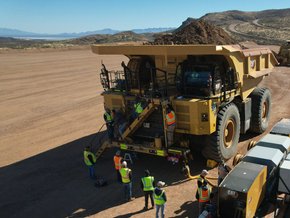Canada Wants its Bite of the Rare Earths Apple

Canadian extractive companies, in collaboration with the federal government and other groups, have launched more than 200 exploration projects targeting what are called rare earth elements (REE). Canada has set its sites on becoming a global leader in the growing multi-billion dollar industry – a goal that the Canadian government views as ‘critical’ for the country’s economy. For the past decade or more, China has dominated the industry and now Canada wants a share of the pie.
Rare earths, which include 15 lanthanide metals on the periodic table plus scandium and yttrium, are increasingly sought after by manufacturing companies. The elements, with their luminous, magnetic and catalytic characteristics are critical for manufacturing new technology, clean energy, automotive, defense, aerospace and other industrial products.
As an example, rare earths have become essential components in the development of electric cars, wind turbines, laptops, cell phones, rechargeable batteries, medical imaging equipment, LCD screens and more. With this in mind, it’s clear that they are potentially very valuable.
Rare earth elements are split into two categories, ‘light’ or ‘heavy’ and it’s the latter, which are said to be critical for the manufacturing of such products.
Canada Reports Elevated Concentrations of ‘Heavy’ Rare Earths
According to a report by Canada.com, Canadian deposits contain high volumes of ‘heavy’ rare earths, meaning that the country is set to reap great rewards:
“Canada is poised to capitalize on extracting rare earth elements, say briefing notes prepared for Natural Resources Minister Joe Oliver as part of last summer’s cabinet shuffle.
“Rare earth elements (REE) have been categorized by the government as being critical to Canada’s economy,” say the briefing notes, titled “Secret” and obtained by Postmedia News under access to information legislation.
“Canada could become a significant producer of rare earths over the medium term.”
By 2018, Canada wants to have 20 percent of global supply. Up until 2013, China produced an astonishing 97 percent of the world’s supply of rare earths and is currently producing 90 percent. The country imposes steep export quotas.
According to Mining.com, the leading Canadian juniors vying to build Canada’s first rare earths mine include Rare Element Resources, Avalon Rare Metals and Quest Rare Minerals, while Saskatoon-based Great Western Minerals is recommissioning the Steenkampskraal mine in South Africa with Chinese backing.
Canada has more than 200 exploration projects searching for rare earth elements, representing more than half of the world’s exploration projects on REE. Furthermore, 11 of those projects are considered to be at an advanced stage of development according to federal officials, seven of which contain elevated concentrations of the valuable ‘heavy’ rare earths.
As it stands, Canada is not actually producing any rare earths, however the briefing notes state that it could become a ‘key player’ over the course of the next four to six years.
Potential Challenges
As with any extractive project, there are environmental challenges. Many of the REE mines are open pit, while rare earths are generally accompanied by uranium and thorium — radioactive elements, albeit in low quantities.
What’s more, building, developing and opening a rare earths mine, including the subsequent processing costs, amounts to $1.5 billion to $2 billion. The importance of rare earths in new manufacturing technology does however mean that each mine could produce tens or even hundreds of billions of dollars. According to reports, rare earths actually aren’t that rare. They are abundant around the world, but very rarely in concentrations that are economically recoverable, which is where the risk element comes in.
Having said this, the briefing notes indicate that at least one of Canada’s advanced projects, from Avalon Rare Metals, is expected to begin production in 2017, with four other projects potentially starting production between 2017 and 2019.
Avalon’s flagship mine is in the Northwest Territories, while other companies like Quest Rare Minerals and Matamec Explorations are proceeding with projects in Quebec.
“Canada may become a major producer of the valued “heavy” rare earth elements by the 2017 to 2020 time period,” say the briefing notes.
Natural Resources Canada (NRCan) is working closely with industry and academia to develop a rare earth industry in Canada, including the training of needed workers.
Any foreign investment in rare earth elements is subject to a national security review under the Investment Canada Act to ensure potential acquisitions don’t pose national security risks.
“NRCan will continue to closely monitor the global rare earth industry and cooperate with other departments to manage future production and shipments of these resource materials consistent with the government’s strategic objectives.”
The future looks bright for Canada’s rare earths industry.






